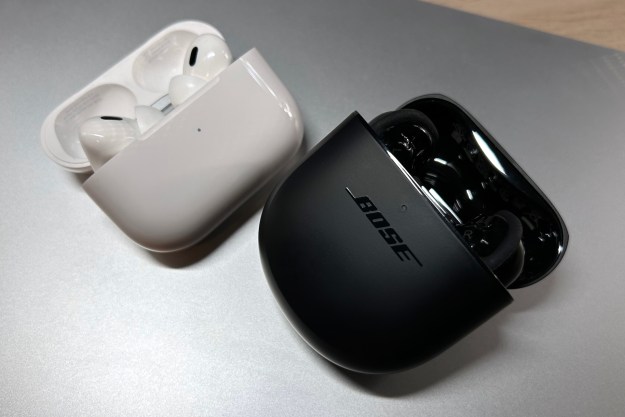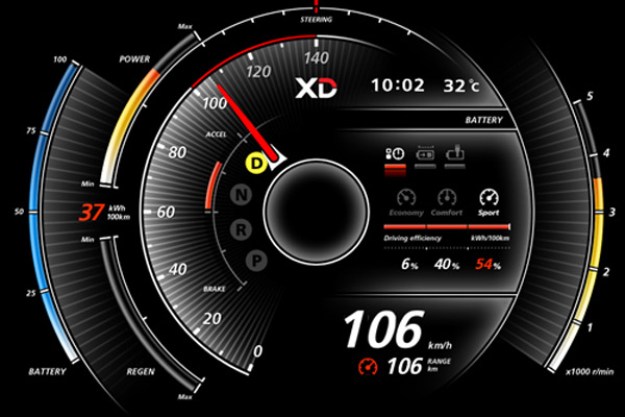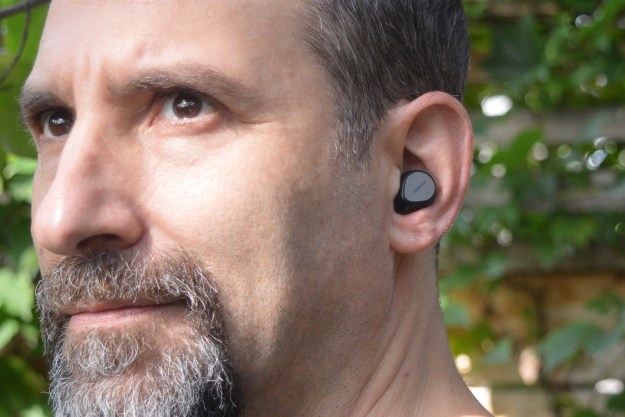
“These Elite 7 Pro get everything right and don't cost a fortune.”
- Super comfortable
- Great sound quality
- Excellent call quality
- Very good ANC and transparency
- Good battery life
- Wireless charging
- Tons of customization options
- Excellent water/dust protection
- None
How do you improve on an awesome set of true wireless earbuds? That’s the question that faced Jabra as it contemplated the design for its new $200 Elite 7 Pro, the successor to its excellent Elite 75t, which proved to be some of the best true wireless earbuds you could buy when they debuted in 2019. The answer, it seems, is to double down on what the Elite 75t got right, and then fill in the missing gaps. Did that formula work out? You bet it did. Let’s take a look.
Design

The Elite 7 Pro are a natural evolution of Jabra’s true wireless designs. They’re just as rounded and ergonomically shaped as the Elite 75t, yet smaller and lighter. When compared to Jabra’s flagship Elite 85t, the 7 Pro are downright tiny. The multifunction buttons now have a teardrop shape and occupy the entire outer surface of the earbuds, making them impossible to miss. The new design also affords much better water protection, with an IP57 rating (the Elite 75t were IP55), making them effectively waterproof.
The Elite 7 Pro are the most comfortable noise-canceling true wireless earbuds you can buy right now.
But the most noticeable change has to be the charging case. Jabra has abandoned its distinctive, upright design with its flip-top lid for a more conventional clamshell shape. It’s ever so slightly larger now, but it also has wireless charging built-in, something you needed to pay extra for in the past.
It might also be the first charging case that puts its charging port on the front instead of the rear. Though not as pretty, it’s eminently more practical.
The lid isn’t quite as easy to open because of its curved sides, but that’s a minor critique of what is otherwise an excellent design. The earbuds snap in and out of their charging sockets with ease — something that has long been one of Jabra’s strengths.
Comfort, controls, and connections

Let’s just get this out of the way: The Elite 7 Pro are the most comfortable noise-canceling true wireless earbuds you can buy right now. The Elite 75t were already mighty comfortable, but Jabra has managed to refine that shape so that they feel even better. The company says it also reengineered the material of the eartips, which probably contributes to their excellent fit. Maybe it’s just the particular shape of my ears, but the Elite 7 Pro feel like they were custom-made for me — I could happily wear them for hours at a time without pain or fatigue. Not sure if you chose the right size of eartips? You can run a fit test within the Sound+ app to find out.
The Elite 7 Pro are the most customizable earbuds I’ve ever tested.
Jabra targets the Elite 7 Active at those who want a set of earbuds for high-intensity activities, and you could totally get away with using the Elite 7 Pro for all but the heaviest of workouts — once in my ears, they didn’t budge at all.
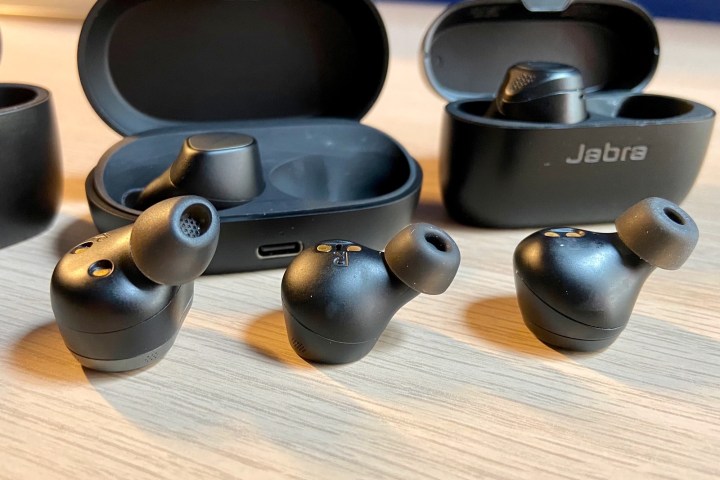
The controls remain the best in the business: Big, easy-to-press physical buttons that offer an unmistakable tactile click when you use them. With single-, double-, and triple-click gestures, plus one for press-and-hold, you can control everything from calls to playback to active noise cancellation (ANC). If you don’t like Jabra’s default control scheme, you can change it within the Jabra Sound+ app, with almost unlimited freedom to pick and choose what each gesture does. In fact, the Elite 7 Pro are the most customizable earbuds I’ve ever tested. If you can think of a function, I guarantee there’s a section in the Sound+ app that lets you modify it.
You can trigger your phone’s built-in voice assistant, or you can configure the Elite 7 Pro to work with Amazon Alexa. With in-ear detection, you can choose to autopause and play your music when you remove or reinsert one of the earbuds.
With Bluetooth 5.2, the Elite 7 Pro are easy to pair and they can stay reliably connected up to 50 feet away (a little less indoors). You can also use the earbuds independently.
They’re pleasure to listen to, no matter your chosen music genre.
When I initially reviewed the Elite 7 Pro in October 2021, it suffered from just one flaw: It lacked Bluetooth Multipoint for connecting to two devices simultaneously. As of January 27, 2022, that has been rectified via a firmware update, removing my only real criticism of these earbuds.
Sound quality
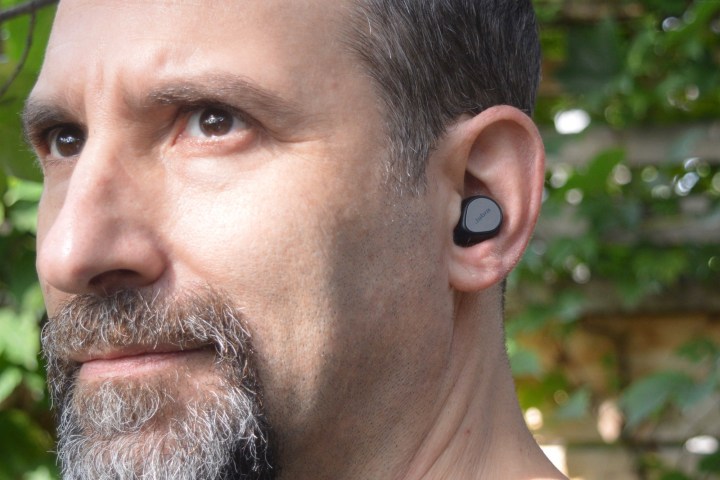
The Elite 75t possessed enormously powerful bass for such small earbuds, so much so that the low end had a tendency to trample on the midranges. You needed to jump into the EQ settings to rein it in. The Elite Active 75t was milder in the bass department but arguably not as clear. The Elite 7 Pro manages to be the best of both worlds, with a deeply resonant low end that is much better controlled.
A track like Billie Eilish’s Bad Guy, where the opening vocals are essentially whispers that float above a thumping bass line, is an ideal test — if the EQ isn’t just right, the tiny nuances in Eilish’s voice are lost under the pressure of the constant beat. The Elite 7 Pro handle it like a champ, not only giving the low end the power it deserves, but also keeping it where it belongs so that Eilish’s shiver-inducing whispers can be heard with excellent clarity.
Jabra’s call quality has always been good, but I was blown away by the Elite 7 Pro.
You can tweak EQ manually or use Jabra’s small selection of presets in the Sound+ app, but I doubt you’ll need to. The factory EQ is so well-balanced for all kinds of music, I didn’t feel the need to change it at all. You can also choose to use the MySound feature in the Sound+ app, which will attempt to personalize the EQ according to your specific hearing profile. I didn’t find it improved things for me, so I kept it turned off, but it doesn’t hurt to try.
Flipping back and forth between the Elite 7 Pro and Jabra’s more expensive Elite 85t proved to be an incredibly tricky comparison. It felt like I could hear a little more detail from the 85t, but you’d literally need to do a side-by-side comparison like I did to notice.
Either way, the Elite 7 Pro are a pleasure to listen to, no matter your chosen genre.
Noise cancellation and transparency
The Elite 85t were Jabra’s first earbuds to offer a hybrid ANC system (the Elite 75t and Active 75t were given ANC with a firmware upgrade, but those buds don’t use the combination of feed-forward and feedback mics that the 85t has). The Elite 7 Pro are better at canceling unwanted sounds than the 85t, but their transparency mode isn’t quite as crystal clear.
I think this is due to the 85t’s semi-open architecture, which lets in a small amount of outside air. That openness simultaneously makes it easier to hear outside sounds and harder to cancel them. The Elite 7 Pro are fully closed, which gives them the noise-canceling edge. The Sound+ app lets you fine-tune the ANC performance, but much like the MySound feature, I didn’t notice a big difference.
The Elite 7 Pro can’t quite keep up with the reigning champs of ANC and transparency — the Bose QuietComfort Earbuds — or the AirPods Pro, but considering their lower price, that’s not surprising and, honestly, the difference isn’t huge.
Flipping between the two modes is almost instant: Whether you want quiet or conversation, one press on the left earbud is all you need.
Call quality
For the Elite 7 Pro, Jabra has used what it calls MultiSensor Voice technology, which aims to provide better voice pickup through bone conduction-sensing mics. It’s not hype. Jabra’s call quality has always been good, but I was blown away by how much better the Elite 7 Pro are at calls than Jabra’s previous buds. I stood in a parking lot on a windy day, with an active construction site just a few yards away, and yet almost none of that was audible during my tests. A small amount of compression worked its way in there during the loudest moments, but in general, it was superb. And in a relatively quiet spot, it was impeccable.
With Jabra’s adjustable sidetone feature, you can let in as much of your voice as you want, and there’s even a microphone-mute feature you can engage while on a call — something that even pricey earbuds like the Sony WF-1000XM4 and Bose QuietComfort Earbuds don’t offer.
All of this makes the Elite 7 Pro an ideal choice for those who like to talk.
Battery life
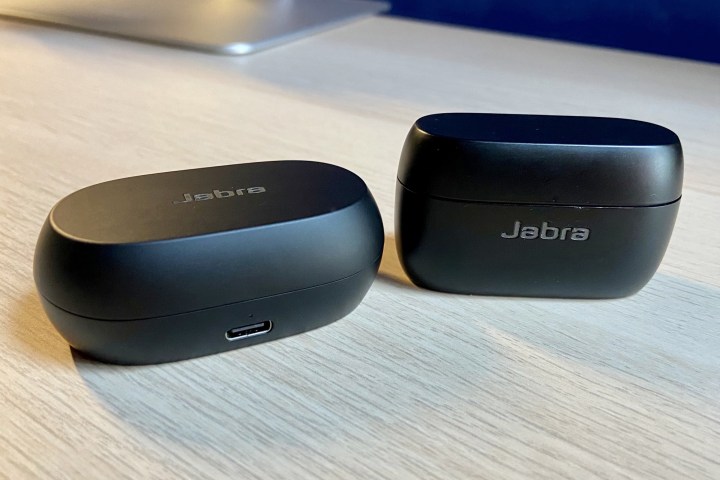
Jabra claims you’ll get up to eight hours per charge on the Elite 7 Pro earbuds with ANC on, and the key here is the “up to” part. I played music continuously on them with ANC on and volume set at 50%, and while the left earbud made it the full eight hours, the right earbud only managed 7.5 hours. Given that the right earbud was the first to connect and thus the “primary” earbud, this makes sense — it has to do more work. A fast charge of five minutes will buy you an extra hour of use if you’re in a pinch.
With the charging case included, you should be able to get 30 hours of total playtime, and likely a good bit more if you keep ANC and transparency turned off. The numbers aren’t at the top end of what true wireless earbuds can do, but they’re more than sufficient for daily use and all but the longest of travel plans.
Extras
In addition to the wealth of capabilities I’ve described above, this review wouldn’t be complete unless I mentioned some of the lesser-known features that Jabra throws in, like Find My earbuds, adjustable auto-power off timing, and your choice of voice guidance, tone guidance, or none at all. You can choose if you want to cycle through ANC, transparency, and off modes when activating the mode switch, or you can choose any two of those modes. There’s a separate EQ setting just for phone calls. In-ear detection can be used to automatically answer phone calls or mute the mics. And finally, the Sound+ app offers a series of “soundscapes,” some of which are designed to mask external sounds, while others are meant to be more relaxing or meditative.
What’s in the box?

Jabra is getting better and better at making sustainable product boxes. The Elite 7 Pro comes in an attractive, yet fully recyclable cardboard box, with only one small plastic blister pack for the extra eartips. Inside, you’ll find the earbuds, their charging case, a USB-A to USB-C charging cable, and three sizes of eartip (mediums are installed by default).
Our take
I’ve tried and failed to find something about the Jabra Elite 7 Pro that I don’t like. At this price, nothing beats them. And while better ANC, transparency, and sound quality are available, for most folks, it simply won’t be worth the extra investment to get them.
Is there a better alternative?
No. Jabra has priced the Elite 7 Pro low enough that they obliterate any other set of earbuds that cost around $150 to $200. Your only real options are to spend more on models like the Sony WF-1000XM4, the Bose QuietComfort Earbuds, or the Master & Dynamic MW08.
How long will they last?
I’m still rocking a set of two-year-old Elite 75t, and while they don’t get constant daily use, they’re still in outstanding shape. I expect the Elite 7 Pro to last for many years. With their IP57 protection, not much will affect them (short of actual immersion in water — don’t do that), and Jabra is so confident in that rating it will extend its normal one-year water and dust warranty to two years if you register your earbuds in the Sound+ app.
Should you buy them?
Yes. They’re an absolutely killer set of true wireless earbuds.
Editors' Recommendations
- What is Sonos? The speakers, app, and everything you need to know about wireless music
- The best wireless headphones for 2023: which should you buy?
- The best noise-canceling headphones of 2023: Sony, Bowers & Wilkins, and more
- Best earbuds for making phone calls for 2023
- Best noise-canceling earbuds for 2023: from Sony, Jabra, and more









